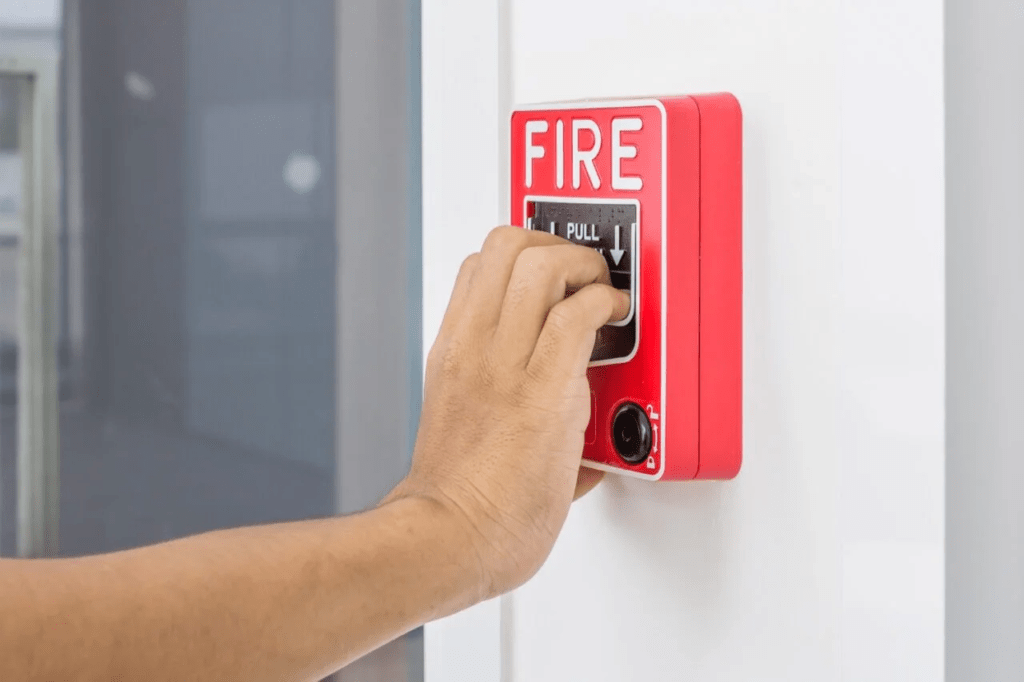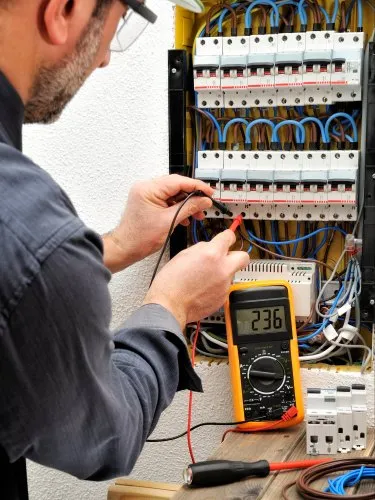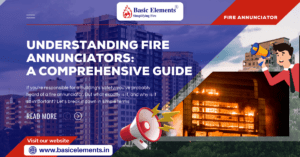Introduction

Fire is one of the most devastating hazards that can strike any building or facility, posing serious risks to human life and property. In such critical situations, a properly functioning fire detection and alarm system can mean the difference between a controlled emergency response and a catastrophic event. However, like any other complex system, fire alarm installations require regular preventive maintenance to ensure their reliability and effectiveness.
This blog aims to provide a comprehensive preventive maintenance checklist for fire detection and alarm systems, highlighting the importance of proactive measures in ensuring fire safety. By following this checklist, building owners, facility managers, and fire safety professionals can identify potential issues, address them promptly, and maintain the optimal performance of their fire alarm systems.
Regular maintenance not only enhances the overall fire safety of a building but also helps comply with relevant regulations and codes. Neglecting these vital systems can lead to severe consequences, including delayed emergency response, unnecessary disruptions, and potential legal liabilities.
Through this blog, we will delve into the essential components of a fire alarm system, the recommended maintenance schedules, and the specific tasks required to keep these life-saving systems in top working condition. By prioritizing preventive maintenance, stakeholders can mitigate fire risks, protect occupants, and safeguard valuable assets.
A well-maintained fire detection and alarm system is crucial for ensuring the safety of people and property in the event of a fire emergency.
Understanding the Importance of Fire Alarm System Maintenance

Fire alarm systems are designed to detect the presence of smoke, heat, or flames and immediately alert occupants and emergency responders. However, like any other complex system, they can malfunction or deteriorate over time due to various factors such as dust accumulation, component wear and tear, or environmental conditions. Regular maintenance helps identify and address these issues before they compromise the system’s effectiveness.
Neglecting fire alarm system maintenance can have severe consequences. A faulty system may fail to detect a fire or provide false alarms, leading to delayed evacuation or unnecessary disruptions. In either case, the consequences could be catastrophic, resulting in loss of life, property damage, and potential legal liabilities.
Proper maintenance of fire alarm systems involves several essential tasks, including:
- Visual inspections: Checking for physical damage, obstructions, or tampering that could interfere with the system’s operation.
- Testing and calibration: Conduct periodic tests to ensure that all components, such as smoke detectors, heat detectors, and manual pull stations, are functioning correctly and within specified parameters.
- Cleaning and maintenance: Removing dust, debris, or other contaminants that could affect the system’s performance, and replacing worn-out or outdated components as necessary.
- Battery backup checks: Verifying that the system’s backup power supply is operational and capable of providing sufficient power during a mains power failure.
- Documentation and record-keeping: Maintaining accurate records of all maintenance activities, test results, and system modifications for compliance and future reference.
Key Components of a Fire Detection and Alarm System
A fire detection and alarm system is a complex network of interconnected components designed to detect the presence of fire, alert occupants, and notify emergency responders. While the specific configuration may vary depending on the building’s size, occupancy type, and local regulations, most systems comprise the following critical elements:
Fire Alarm Control Panel (FACP): The FACP serves as the brain of the entire system, monitoring and controlling all connected devices. It processes incoming signals from various detection devices and initiates appropriate responses, such as sounding alarms or notifying monitoring stations.
Initiating Devices:
- Smoke Detectors: These devices detect the presence of smoke particles in the air, which can be an early indicator of a fire.
- Heat Detectors: Designed to sense abnormally high temperatures, heat detectors can identify fires in areas where smoke may not be present.
- Manual Pull Stations: Located near exits or along evacuation routes, these allow occupants to manually trigger the alarm system in case of a fire.
Notification Appliances:
- Audible Devices (Horns/Speakers): These produce loud, distinct sounds to alert occupants of a fire emergency and prompt evacuation.
- Visual Devices (Strobes): Strobe lights provide visual cues to occupants who may be hearing-impaired or in areas where audible alarms may not be easily heard.
Power Supply: Fire alarm systems require a reliable power source, typically consisting of a primary power supply (e.g., mains electricity) and a backup battery system to ensure continuous operation during power outages.
Wiring and Circuits: A robust network of wiring and circuits connects all components of the system, facilitating communication and signal transmission. Proper installation and maintenance of these circuits are crucial for system reliability.
Monitoring and Reporting: Many fire alarm systems are equipped with monitoring capabilities, allowing them to transmit signals to off-site monitoring stations or emergency response centers, ensuring prompt notification and response.
Annunciators and Graphical User Interfaces (GUIs): These visual displays provide real-time information about the system’s status, including the location of activated devices, enabling quick identification and response to potential fire incidents.
Monthly Preventive Maintenance Checklist for Fire Alarm Systems

Conducting regular monthly inspections and maintenance tasks is crucial to ensure the proper functioning of your fire alarm system. By following this checklist, you can identify potential issues early and take corrective actions to maintain the system’s reliability and effectiveness.
Visual Inspection:
- Check the control panel for any trouble or supervisory signals.
- Inspect all initiating devices (smoke detectors, heat detectors, and manual pull stations) for physical damage, obstructions, or tampering.
- Examine notification appliances (horns, strobes) for any visible signs of damage or obstruction.
- Inspect the battery backup system, including battery condition and charging status.
Functional Testing:
- Test a sample of initiating devices (detectors and pull stations) by following the manufacturer’s recommended procedures.
- Verify that all notification appliances (audible and visual) are functioning correctly when activated.
- Check the system’s ability to transmit signals to off-site monitoring stations or emergency response centers (if applicable).
Record Keeping:
- Document all inspection and testing activities, including any deficiencies or issues identified.
- Review previous maintenance records to identify any recurring problems or patterns.
Housekeeping:
- Clean all accessible smoke detectors and remove any dust or debris that may have accumulated.
- Ensure that all manual pull stations are unobstructed and easily accessible.
- Check for any potential obstructions or hazards that could interfere with the operation of notification appliances.
Battery Backup System:
- Inspect the battery terminals for corrosion or loose connections.
- Verify that the battery backup system is operational by simulating a power outage or conducting a load test (if recommended by the manufacturer).
System Software and Firmware Updates:
- Check with the manufacturer or service provider for any available software or firmware updates that may improve system performance or address known issues.
It’s important to note that this monthly checklist serves as a general guideline, and you should always refer to the manufacturer’s specific recommendations and local regulations for your fire alarm system.
Annual Comprehensive Testing and Inspection of Fire Alarm Systems
While monthly inspections and maintenance are essential, fire alarm systems require a more thorough and comprehensive evaluation at least once a year. An annual inspection and testing process helps identify any potential issues that may have gone unnoticed during routine checks and ensures the system’s overall reliability and compliance with local regulations.
The annual comprehensive testing and inspection should cover the following aspects:
Control Panel and System Components:
- Conduct a thorough visual inspection of the fire alarm control panel, including wiring, connections, and components.
- Test all system functions, such as alarm initiation, notification appliance circuits, and signal transmission to monitoring stations.
- Verify the correct programming and operation of system features like time controls, sensitivity levels, and event logs.
Initiating Devices:
- Test all smoke detectors, heat detectors, and manual pull stations to ensure proper operation and sensitivity levels.
- Inspect the physical condition and placement of these devices, ensuring they are free from obstructions and installed in appropriate locations.
Notification Appliances:
- Conduct a thorough operational test of all audible and visual notification appliances, including horns, speakers, and strobes.
- Verify that the sound pressure levels and visual intensity meet the requirements for the protected area.
Power Supply and Battery Backup:
- Perform a full load test on the battery backup system to ensure it can adequately support the system during power outages.
- Check the battery terminals for corrosion and ensure proper charging and maintenance.
Wiring and Circuit Integrity:
- Test the integrity of all wiring and circuits, including initiating device circuits, notification appliance circuits, and signaling line circuits.
- Inspect for any physical damage or potential interference that could compromise the system’s operation.
Monitoring and Reporting:
- Verify that the system is correctly transmitting signals to off-site monitoring stations or emergency response centers.
- Test the communication paths and backup methods to ensure reliable reporting in case of primary path failure.
Documentation and Record Keeping:
- Review and update all system documentation, including drawings, manuals, and maintenance records.
- Document all testing and inspection activities, including any deficiencies or issues identified and the corrective actions taken.
It’s crucial to involve qualified and experienced professionals, such as certified fire alarm technicians or inspectors, to conduct the annual comprehensive testing and inspection.
Documenting and Addressing Fire Alarm System Issues
Proper documentation and timely resolution of fire alarm system issues are crucial for maintaining the system’s reliability and effectiveness. By keeping accurate records and promptly addressing any identified problems, building owners and facility managers can ensure that their fire safety systems remain in optimal working condition.
Documentation:
Maintenance Log: Maintain a detailed log that records all inspection, testing, and maintenance activities performed on the fire alarm system. This log should include the date, time, personnel involved, tasks performed, and any issues or deficiencies identified.
Deficiency Reports: When issues or deficiencies are discovered during inspections or testing, create a detailed report that includes the specific problem, its location, potential causes, and any immediate corrective actions taken.
Service Reports: Keep copies of all service reports provided by technicians or contractors who perform repairs, upgrades, or modifications to the fire alarm system. These reports should document the work performed, parts replaced, and any recommendations for future maintenance or improvements.
System Drawings and Manuals: Maintain up-to-date drawings and technical manuals for the fire alarm system, including wiring diagrams, component specifications, and manufacturer instructions. These documents will be invaluable for troubleshooting and future upgrades or expansions.
Addressing Issues:
- Prioritization: Categorize identified issues based on their severity and potential impact on the system’s performance. Issues that could compromise life safety or system functionality should be given the highest priority for resolution.
- Root Cause Analysis: Conduct a thorough investigation to determine the root cause of any recurring or complex issues. Understanding the underlying cause is essential for implementing effective and long-lasting solutions.
- Corrective Actions: Develop and implement a plan to address identified issues, which may involve repairs, replacements, or system modifications. Work closely with qualified technicians or contractors to ensure that corrective actions are carried out properly and in compliance with applicable codes and standards.
- Follow-up Testing and Verification: After corrective actions have been taken, perform follow-up testing and verification to ensure that the issues have been resolved and that the fire alarm system is functioning correctly.
- Preventive Maintenance Adjustments: Based on the issues encountered and their root causes, review and adjust the preventive maintenance schedule and procedures as necessary to prevent similar problems from occurring in the future.
By maintaining accurate and comprehensive documentation, and promptly addressing any issues that arise, building owners and facility managers can ensure the continued reliability and effectiveness of their fire alarm systems.






